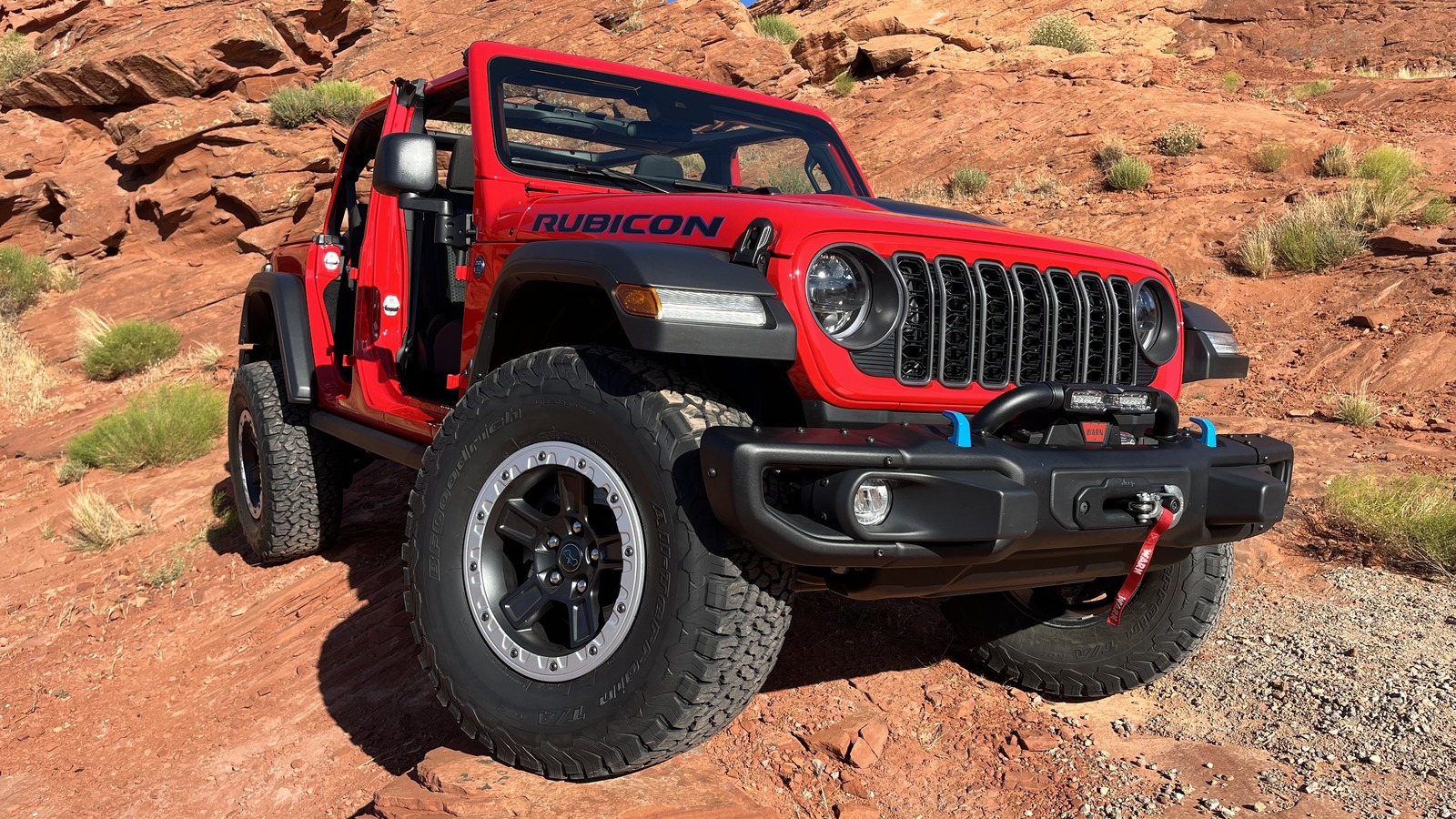The Rhythmic Riddle: Unraveling the Jeep SRT Hemi Tick
The Rhythmic Riddle: Unraveling the Jeep SRT Hemi Tick jeeps.truckstrend.com
The roar of a Jeep Grand Cherokee SRT Hemi engine is a symphony of power, a testament to American muscle, and a thrilling experience for any enthusiast. However, a specific, less harmonious sound has long been a topic of discussion, concern, and sometimes, anxiety among owners: the "Jeep SRT Hemi Tick." This distinctive rhythmic tapping or ticking sound emanating from the engine bay has become almost synonymous with the Hemi experience, raising questions about its origin, severity, and potential impact on the engine’s longevity.
This comprehensive article aims to demystify the Jeep SRT Hemi Tick. We will delve into its nature, explore its most common causes, guide you through diagnostic steps, discuss potential solutions, and provide actionable insights to help you understand and address this peculiar engine characteristic. Whether you’re a seasoned SRT owner or considering purchasing one, understanding the Hemi Tick is crucial for peace of mind and proper vehicle maintenance.
The Rhythmic Riddle: Unraveling the Jeep SRT Hemi Tick
Understanding the Hemi Engine and Its Design
To truly grasp the Hemi Tick, it’s essential to appreciate the engine itself. The Hemi, short for hemispherical combustion chamber, is a V8 engine design famed for its robust power output and distinctive deep growl. In Jeep SRT models, these engines (primarily the 6.1L, 6.4L, and later supercharged 6.2L Hellcat variants) are engineered for high performance, delivering prodigious horsepower and torque.
At the heart of any internal combustion engine is the valvetrain, a complex system of components that precisely control the opening and closing of intake and exhaust valves. This system typically includes the camshaft, lifters (or tappets), pushrods, rocker arms, and the valves themselves. In modern Hemi engines, hydraulic roller lifters are used, which rely on oil pressure to maintain zero valve lash, ensuring quiet and efficient operation. Additionally, the exhaust system, including the manifolds, plays a critical role in expelling combustion gases. Any component within these systems, or even the interaction between them, can be a potential source of an unwanted noise like a tick.
The Nature of the Hemi Tick: What it Sounds Like and When it Occurs
The Jeep SRT Hemi Tick is typically described as a distinct, rhythmic tapping or ticking sound, often likened to a sewing machine, a faint metallic tap, or even a persistent clock-like beat. It’s crucial to distinguish this from the normal mechanical noises inherent in any internal combustion engine, such as the subtle clicks of fuel injectors or the general hum of moving parts. The Hemi Tick is often louder and more pronounced than these background noises.
Owners typically report the tick being most noticeable in specific scenarios:
- Cold Start: The sound is frequently loudest immediately after a cold start, especially after the vehicle has sat for several hours or overnight.
- Idle: While idling, particularly when the engine is cold or warming up, the tick can be quite apparent.
- Low RPMs/Light Load: Some owners report hearing it more prominently at lower engine speeds or under light throttle application.
- Engine Temperature Changes: The sound may diminish or disappear once the engine reaches operating temperature, only to return on subsequent cold starts. In more severe cases, it can persist even when warm.

Understanding these patterns is the first step in diagnosing the tick, as they can provide valuable clues about its underlying cause.
Common Causes of the Hemi Tick
While the term "Hemi Tick" is singular, its causes are manifold. Pinpointing the exact origin requires careful diagnosis, as different issues can produce similar sounds. Here are the most common culprits:
-
Exhaust Manifold Leaks/Cracks: This is arguably the most frequent and often least severe cause of a "tick" that many owners experience. As the engine heats up and cools down, the exhaust manifolds, particularly the cast-iron ones on earlier Hemi generations, can expand and contract. This stress can lead to:

- Cracked Manifolds: Small hairline cracks can form, allowing exhaust gases to escape.
- Failed Gaskets: The gasket sealing the manifold to the cylinder head can degrade or blow out.
- Loose or Broken Bolts: Manifold bolts can stretch, corrode, or break, reducing clamping force and creating a leak.
When cold, the metal contracts, opening these gaps further, allowing exhaust pulses to "tick" as they escape. As the engine warms up, the metal expands, often sealing the gap and causing the tick to diminish or disappear.
-
Hydraulic Lifter Failure/Wear: This is the most concerning and potentially expensive cause of the Hemi Tick. Hemi engines, especially those equipped with Multi-Displacement System (MDS) – a cylinder deactivation technology – are known to sometimes suffer from premature lifter wear or failure.
- How it happens: Hydraulic lifters rely on a precise amount of oil pressure to maintain zero lash between the camshaft and the valvetrain. If a lifter fails to pump up properly (due to internal wear, debris, or inadequate oil supply), it will create excessive clearance, leading to a distinct tapping sound as the rocker arm impacts the valve stem or pushrod.
- Camshaft Damage: A failing lifter, particularly if its roller seizes or wears flat, will rapidly damage the corresponding lobe on the camshaft. This "flat cam" issue amplifies the tick and leads to misfires and significant performance loss.
- MDS Lifters: The MDS lifters are more complex than standard lifters and are often cited as a particular point of failure due to their intricate design and the stresses of activating/deactivating cylinders.
-
Camshaft Wear: Directly related to lifter failure, the camshaft can develop flat spots or excessive wear on its lobes. This can be caused by prolonged lifter issues, poor lubrication, or manufacturing defects. A worn camshaft will inevitably lead to a loud, persistent tick and reduced engine performance.
-
Oil Viscosity and Maintenance: The type and condition of engine oil play a crucial role in preventing valvetrain noise.
- Incorrect Viscosity: Using oil that is too thick (high viscosity) can hinder proper lubrication and lifter pump-up, especially on cold starts. Conversely, oil that is too thin might not provide adequate cushioning. Jeep SRT engines typically require specific synthetic oil viscosities (e.g., 0W-40 for newer models, 5W-20 for older 6.1L), and deviation can cause issues.
- Extended Oil Change Intervals: Dirty or degraded oil loses its lubricating properties and can lead to sludge buildup, restricting oil passages and preventing lifters from functioning correctly. Regular oil changes with quality synthetic oil are paramount.
-
Fuel Injector Noise: While not a "tick" in the same vein as the others, the rapid clicking of fuel injectors can sometimes be mistaken for a valvetrain tick. Injector noise is typically a sharper, more rapid click, often more localized to the top of the engine near the fuel rail, and doesn’t usually signify a problem.
Diagnosing the Hemi Tick: A Step-by-Step Approach
Accurate diagnosis is key to addressing the Hemi Tick effectively. Here’s a systematic approach:
-
Listen Carefully and Localize the Sound:
- Use a Mechanic’s Stethoscope: This inexpensive tool is invaluable. Place the probe on different areas of the engine (valve covers, exhaust manifolds, oil pan) to pinpoint the source of the loudest tick.
- Isolate Sides: Determine if the sound is coming from the driver’s side or passenger’s side of the engine.
- Top vs. Bottom: Is it louder near the valve covers (valvetrain) or lower down (exhaust manifolds, or deep within the block for severe lifter/cam issues)?
-
Observe Sound Characteristics with Engine Temperature:
- Cold Start: Does the tick appear immediately on cold start and then disappear as the engine warms up? This strongly suggests an exhaust manifold leak.
- Persistent When Warm: If the tick remains loud and constant even after the engine reaches operating temperature, it’s a much stronger indicator of a valvetrain issue (lifter/cam).
-
Check Oil Level and Condition:
- Level: Ensure the oil level is correct. Low oil can starve lifters.
- Color/Consistency: Check for signs of sludge, excessive dirt, or metallic flakes (a serious warning sign).
- Type and Age: Confirm the correct oil viscosity is being used and that it’s not overdue for a change.
-
Visual Inspection for Exhaust Leaks:
- Look for Soot: Inspect the exhaust manifolds and surrounding areas for black soot stains, which indicate an exhaust leak.
- Broken Bolts: Visually check manifold bolts for signs of corrosion, looseness, or breakage. This often requires looking from underneath the vehicle.
-
Professional Diagnosis:
- When in Doubt: If you suspect a lifter or camshaft issue, or if the tick persists after checking for exhaust leaks, it’s crucial to consult a qualified mechanic specializing in Hemi engines.
- Advanced Diagnostics: Professionals can perform compression tests, leak-down tests, and sometimes use specialized listening equipment or even remove valve covers for visual inspection to confirm lifter/camshaft wear. They might also check oil pressure.
Addressing the Hemi Tick: Solutions and Preventive Measures
The solution to the Hemi Tick depends entirely on its root cause.
-
Exhaust Manifold Repair/Replacement:
- Gasket/Bolt Replacement: If the leak is due to a failed gasket or loose/broken bolts, replacing these components is a relatively straightforward fix.
- Manifold Replacement: If the manifold itself is cracked, it will need to be replaced. Aftermarket headers are a popular upgrade for performance and can also eliminate manifold cracking issues. This is generally the least expensive "repair" for a persistent tick.
-
Lifter/Camshaft Replacement:
- The Major Repair: This is the most invasive and costly solution. It involves significant engine disassembly, often requiring the removal of cylinder heads, intake manifold, and timing components.
- Parts Involved: Typically, all lifters (especially if MDS is present, as it’s wise to replace all of them), the camshaft, pushrods, and often new head gaskets and bolts are replaced. Sometimes, rocker arms are also replaced if wear is found.
- Why it’s done: To restore proper valvetrain function, eliminate the tick, and prevent catastrophic engine failure.
-
Optimal Oil Management:
- Correct Viscosity: Always use the manufacturer-recommended synthetic oil viscosity (e.g., 0W-40 or 5W-20 for SRT models). Consult your owner’s manual.
- Regular Changes: Adhere strictly to the recommended oil change intervals, typically 6 months or 6,000-10,000 miles, depending on driving conditions and oil type. Consider shorter intervals if you drive aggressively or track the vehicle.
- Quality Oil and Filter: Invest in high-quality synthetic oil and a reputable oil filter.
-
Oil Additives (Use with Caution):
- Some owners report temporary relief from minor ticks using oil additives designed to clean sludge or improve lubrication. However, these are generally not a fix for mechanical wear and should be used judiciously and only after professional consultation. They are not a substitute for proper repairs.
-
MDS Deactivation (Advanced Consideration):
- For some Hemi owners, particularly those with 5.7L engines (though 6.4L also has MDS), disabling the MDS system via a custom tune or a bypass module is considered. The theory is that the constant activation and deactivation of MDS lifters contribute to their wear. While this can potentially reduce the risk of future lifter issues, it will impact fuel economy and may void warranties or violate emissions regulations. This is a personal choice that requires careful consideration.
Impact and Considerations for Owners
- Peace of Mind vs. Urgency: A persistent, loud tick that doesn’t go away when warm should be addressed promptly. A minor, cold-start-only tick that disappears quickly is likely an exhaust leak and less urgent, though still worth investigating.
- Cost of Repairs: Repairs can range dramatically:
- Exhaust manifold gasket/bolt replacement: Hundreds of dollars.
- Exhaust manifold replacement: $500 – $1,500+.
- Lifter/Camshaft replacement: Thousands of dollars, potentially $3,000 – $7,000+ depending on the shop, parts used, and extent of damage.
- Resale Value: An unresolved Hemi Tick can significantly deter potential buyers and reduce the resale value of your Jeep SRT. Transparency and documentation of diagnosis/repair are important.
- Warranty: Check your vehicle’s warranty status. If it’s still under powertrain warranty, a lifter/cam issue might be covered by the manufacturer.
Practical Advice and Actionable Insights
- Don’t Ignore It: While not every tick is catastrophic, ignoring a persistent or worsening sound can lead to more severe and expensive damage.
- Start Simple: Begin your diagnosis with the easiest and most common causes, like checking for exhaust leaks.
- Regular, Meticulous Maintenance: This is your best defense. Adhere to all scheduled maintenance, especially oil changes with the correct type and viscosity of synthetic oil.
- Seek Specialized Help: If you suspect a serious internal engine issue, find a reputable mechanic or dealership with experience in Hemi engines. Their expertise and specialized tools are invaluable.
- Document Everything: Keep records of all maintenance and repairs, especially if you plan to sell the vehicle in the future.
Table: Estimated Costs for Hemi Tick Solutions
Please note: These are estimated ranges and can vary significantly based on your geographic location, the specific mechanic or dealership, parts quality (OEM vs. aftermarket), and the complexity of the repair.
| Repair Type | Parts Cost (Estimated) | Labor Cost (Estimated) | Total Cost (Estimated) | Notes |
|---|---|---|---|---|
| Exhaust Manifold Gasket/Bolts | $50 – $200 | $200 – $500 | $250 – $700 | Often involves seized/broken bolts, increasing labor. |
| Single Exhaust Manifold (Cracked) | $150 – $500 | $300 – $800 | $450 – $1,300 | Cost per manifold. May need both. Aftermarket headers are an option. |
| Full Set of Lifters (OEM) | $400 – $800 | N/A (Included in labor) | N/A | Parts only. Often includes MDS and non-MDS lifters. |
| Camshaft (OEM) | $300 – $700 | N/A (Included in labor) | N/A | Parts only. |
| Lifter & Camshaft Replacement | $700 – $1,500+ | $2,000 – $5,000+ | $2,700 – $6,500+ | Highly variable. Includes new lifters, cam, pushrods, gaskets, fluids. |
| Full Hemi Tick Repair (Severe) | $1,000 – $2,500+ | $3,000 – $6,000+ | $4,000 – $8,500+ | Comprehensive job including heads, lifters, cam, etc. for extensive damage. |
| Oil Change (Premium Synthetic) | $50 – $100 | $20 – $50 | $70 – $150 | Preventive maintenance, not a repair. |
Frequently Asked Questions (FAQ)
Q1: Is the Hemi tick always serious?
A1: No. A common cause is a minor exhaust manifold leak, especially noticeable on cold starts, which is generally not serious. However, a persistent, loud tick that doesn’t go away when warm is often indicative of a more serious valvetrain issue (lifter/camshaft wear) that requires immediate attention.
Q2: Can I drive with the Hemi tick?
A2: If it’s a minor exhaust leak, you can likely drive it, but it’s best to get it fixed to prevent further damage or exhaust fumes entering the cabin. If it’s a lifter/camshaft issue, prolonged driving can lead to catastrophic engine failure and should be avoided until repaired.
Q3: Does synthetic oil prevent the Hemi tick?
A3: Using the correct type and viscosity of high-quality synthetic oil, changed at recommended intervals, is crucial for optimal lifter operation and can significantly reduce the risk of developing a lifter-related tick. However, it cannot prevent issues caused by manufacturing defects, extreme wear, or exhaust manifold problems.
Q4: What’s the difference between a Hemi tick and injector noise?
A4: Fuel injector noise is typically a sharper, faster, and less intrusive clicking sound, often localized to the top of the engine near the fuel rail. A Hemi tick (from valvetrain issues) is usually a deeper, more pronounced, rhythmic tap that can be louder and more concerning. An exhaust leak tick often changes with engine temperature.
Q5: How long does the repair for a Hemi tick take?
A5: An exhaust manifold repair might take a few hours to a day. A lifter and camshaft replacement is a much more extensive job, often requiring 1-3 days of labor, depending on the mechanic’s experience and shop schedule.
Q6: Is the Hemi tick covered by warranty?
A6: If your Jeep SRT is still under its factory powertrain warranty, a lifter or camshaft failure would typically be covered. Exhaust manifold issues might be covered under the basic warranty if it’s within the mileage/time limits. Always consult your specific warranty documentation and a dealership service center.
Conclusion
The Jeep SRT Hemi Tick, while a common concern, is a multifaceted issue with various potential causes. From the relatively benign exhaust manifold leak to the more significant lifter and camshaft wear, understanding the nuances of this engine characteristic is vital for any Hemi owner.
The key takeaway is to never ignore a persistent or worsening tick. Early and accurate diagnosis, followed by appropriate action, can save you significant time, money, and stress down the road. By adhering to meticulous maintenance schedules, utilizing the correct lubricants, and seeking professional help when necessary, you can ensure your iconic Jeep SRT Hemi continues to deliver its thrilling performance for many miles to come, free from the rhythmic riddle of the tick.





